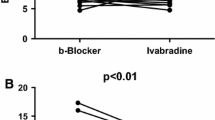Abstract
This study was undertaken to evaluate the effect of flecainie (Fle) and propafenone (Pro) on rest and exercise myocardial contractility after prolonged oral administration. Standardized, fully automated, gated radionuclide angiograms at rest and during maximum excercise were performed single blinded and prospectively in 19 patients before and after oral treatment with either 150 mg b.i.d. of Fle or 150 mg t.i.d. of Pro. The left ventricular ejection fraction (EF %) as a hemodynamic indicator presented as follows:

In general, there was no significant effect of either drug on resting ventricular function. In only one patient of the Fle group with decreased baseline function did the left ventricular EF fall from 40% to 29%. During exercise, ventricular performance showed deterioration in the Pro group, but, interestingly, improvement in the Fle group. As a result of these opposite changes, the effect of the two drugs on the exercise response of ventricular function was significantly different (P<0.05). This study thus gives first evidence that no significant cardiodepressive effects are to be expected after prolonged application of Fle or Pro in normal hearts. There might even be a mild benefical effect on exercise performance after Fle.
Similar content being viewed by others
References
Angermann C, Jahrmärker H (1983) Vergleichende Untersuchungen zur kardiodepressorischen Wirkung von Disopyramid, Mexiletin und Propafenon. Z Kardiol 72:665–670
Beck OA, Vogt J, Hochrein H (1978) Der Einfluß von Antiarrhythmika auf die Hämodynamik bei akutem Myokardinfarkt. Z Kardiol 67:41–46
Bender F, Crohnheim G (eds) (1984) Flecainid. Gustav Fischer, Stuttgart New York
Bramann HU, Bender F, Große-Heitmeyer W (1984) Langzeittherapie mit Flecaninide. Z Kardiol 73:724–731
Flowers D, O-Gallagher D, Torres V, Miurad D, Somberg JV (1985) Flecainide: long-term treatment using a reduced dosing schedule. Am J Cardiol 55:79–83
Henze E, Tymiec A, Delagardelle C, Adam WE, Stauch M (1986 a) Improved specification of regional wall motion abnormalities by phase analysis of radionuclide angiograms in CAD and nonCAD patients. J Nucl Med 27:781–786
Henze E, Bitter F, Weller R, Stauch M (1986b) Phasen- und Amplitudenanalyse zur Spezifizierung regionaler Wandbewegungsstörungen in der Radionuklid-Ventrikulographie. Der Nuklearmediziner 9:3–13
Hodges M (1984) Die Wirkung von Flecainid auf hämodynamische Parameter in Probanden und in herzkranken Patienten. In: Flecainid — Experimentelle Befunde und klinische Erfahrungen. Bender F, Cronheim G (Hrsg) Stuttgart New York, Fischer, 2. Auflage, pp 59–69
Hodges M, Haughland JM, Granrud G, Asinger RW, Mikell FL, Kreijci J (1982) Suppression of ventricular ectopic depolarizations by flecainide acetate, a new antiarrhythmic agent. Circulation 65:879–885
Holtzman JL, Berry DA, Kvam DC, Mottonen L, Borrel G (1984) Application of second-order polynomial equations to the study of pharmacodynamic interactions: the effect of flecainide acetate and propranolon on cardiac output and vascular resistance. J Pharmacol Exp Ther 231:286–289
Josephson MA, Ikeda N, Singh BN (1984) Effects of flecainide on ventricular function: clinical and experimental correlations. Am J Cardiol 53: 95 B
Josephson MA, Kaul S, Hopkins J, Kvam D, Singh BN (1985) Hemodynamic effects of intravenous flecainide relative to the level of ventricular function in patients with coronary artery disease. Am Heart J 109:41–45
Legrand V, Vandormael M, Collignon P, Kulbertus HE (1983) Hemodynamic effects of a new antiarrhythmic agent, flecainide (R-818), in coronary heart disease. Am J Cardiol 51:422–426
Lown B, Graboys TB (1977) Malignant ventricular arrhythmias. Am J Cardiol 39:912–922
Marshall RC, Wisenberg G, Schelbert HR, Henze E (1981) Effect of oral propranolol on rest, exercise and postexercise left ventricular performance in normals and in patients with coronary artery disease. Circulation 63:572–583
Podrid PJ, Lown B (1984) Propafenone: a new agent for ventricular arrhythmia. J Am Coll Cardiol 4:117–126
Serruys PW, Vanhaleweyk G, Van den Brand M, Verdouw P (1983) The hemodynamic effect of intravenous flecainide acetate in patients with coronary artery disease. Br J Clin Pharmacol 16:51–59
Shen EN, Sung RJ, Morady F (1984) Electrophysiologic and hemodynamic effects of intravenous propafenone in patients with recurrent ventricular tachycardia. J Am Coll Cardiol 3:1291–1302
Vanhaleweyk G, Serruys PW, Hugenholz PG (1984) Hemodynamic effects of encainide, flecainide, lorcainide and tocainide. Eur Heart J [Suppl B] 5:67–74
Wester HA, Mouselimis N (1982) Einfluß von Antiarrhythmika auf die Myokardfunktion. Dtsch Med Wochenschr 107:1262–1271
Author information
Authors and Affiliations
Rights and permissions
About this article
Cite this article
Henze, E., Roth, J., Kohler, J. et al. Long term inotropic effects of flecainide and propafenone. Eur J Nucl Med 13, 568–571 (1988). https://doi.org/10.1007/BF02574769
Received:
Issue Date:
DOI: https://doi.org/10.1007/BF02574769




